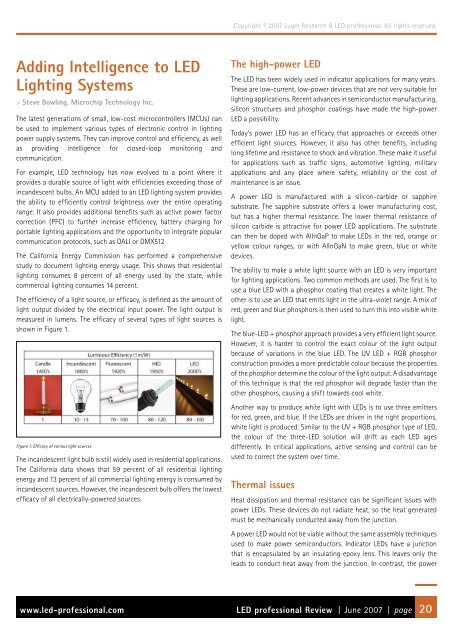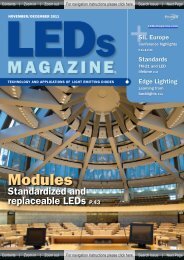LED drivers Phosphor technology - Beriled
LED drivers Phosphor technology - Beriled
LED drivers Phosphor technology - Beriled
You also want an ePaper? Increase the reach of your titles
YUMPU automatically turns print PDFs into web optimized ePapers that Google loves.
Adding Intelligence to <strong>LED</strong><br />
Lighting Systems<br />
> Steve Bowling, Microchip Technology Inc.<br />
The latest generations of small, low-cost microcontrollers (MCUs) can<br />
be used to implement various types of electronic control in lighting<br />
power supply systems. They can improve control and efficiency, as well<br />
as providing intelligence for closed-loop monitoring and<br />
communication.<br />
For example, <strong>LED</strong> <strong>technology</strong> has now evolved to a point where it<br />
provides a durable source of light with efficiencies exceeding those of<br />
incandescent bulbs. An MCU added to an <strong>LED</strong> lighting system provides<br />
the ability to efficiently control brightness over the entire operating<br />
range. It also provides additional benefits such as active power factor<br />
correction (PFC) to further increase efficiency, battery charging for<br />
portable lighting applications and the opportunity to integrate popular<br />
communication protocols, such as DALI or DMX512<br />
The California Energy Commission has performed a comprehensive<br />
study to document lighting energy usage. This shows that residential<br />
lighting consumes 8 percent of all energy used by the state, while<br />
commercial lighting consumes 14 percent.<br />
The efficiency of a light source, or efficacy, is defined as the amount of<br />
light output divided by the electrical input power. The light output is<br />
measured in lumens. The efficacy of several types of light sources is<br />
shown in Figure 1.<br />
Figure 1: Efficacy of various light sources<br />
The incandescent light bulb is still widely used in residential applications.<br />
The California data shows that 59 percent of all residential lighting<br />
energy and 13 percent of all commercial lighting energy is consumed by<br />
incandescent sources. However, the incandescent bulb offers the lowest<br />
efficacy of all electrically-powered sources.<br />
Copyright © 2007 Luger Research & <strong>LED</strong> professional. All rights reserved.<br />
The high-power <strong>LED</strong><br />
The <strong>LED</strong> has been widely used in indicator applications for many years.<br />
These are low-current, low-power devices that are not very suitable for<br />
lighting applications. Recent advances in semiconductor manufacturing,<br />
silicon structures and phosphor coatings have made the high-power<br />
<strong>LED</strong> a possibility.<br />
Today’s power <strong>LED</strong> has an efficacy that approaches or exceeds other<br />
efficient light sources. However, it also has other benefits, including<br />
long lifetime and resistance to shock and vibration. These make it useful<br />
for applications such as traffic signs, automotive lighting, military<br />
applications and any place where safety, reliability or the cost of<br />
maintenance is an issue.<br />
A power <strong>LED</strong> is manufactured with a silicon-carbide or sapphire<br />
substrate. The sapphire substrate offers a lower manufacturing cost,<br />
but has a higher thermal resistance. The lower thermal resistance of<br />
silicon carbide is attractive for power <strong>LED</strong> applications. The substrate<br />
can then be doped with AlInGaP to make <strong>LED</strong>s in the red, orange or<br />
yellow colour ranges, or with AlInGaN to make green, blue or white<br />
devices.<br />
The ability to make a white light source with an <strong>LED</strong> is very important<br />
for lighting applications. Two common methods are used. The first is to<br />
use a blue <strong>LED</strong> with a phosphor coating that creates a white light. The<br />
other is to use an <strong>LED</strong> that emits light in the ultra-violet range. A mix of<br />
red, green and blue phosphors is then used to turn this into visible white<br />
light.<br />
The blue-<strong>LED</strong> + phosphor approach provides a very efficient light source.<br />
However, it is harder to control the exact colour of the light output<br />
because of variations in the blue <strong>LED</strong>. The UV <strong>LED</strong> + RGB phosphor<br />
construction provides a more predictable colour because the properties<br />
of the phosphor determine the colour of the light output. A disadvantage<br />
of this technique is that the red phosphor will degrade faster than the<br />
other phosphors, causing a shift towards cool white.<br />
Another way to produce white light with <strong>LED</strong>s is to use three emitters<br />
for red, green, and blue. If the <strong>LED</strong>s are driven in the right proportions,<br />
white light is produced. Similar to the UV + RGB phosphor type of <strong>LED</strong>,<br />
the colour of the three-<strong>LED</strong> solution will drift as each <strong>LED</strong> ages<br />
differently. In critical applications, active sensing and control can be<br />
used to correct the system over time.<br />
Thermal issues<br />
Heat dissipation and thermal resistance can be significant issues with<br />
power <strong>LED</strong>s. These devices do not radiate heat, so the heat generated<br />
must be mechanically conducted away from the junction.<br />
A power <strong>LED</strong> would not be viable without the same assembly techniques<br />
used to make power semiconductors. Indicator <strong>LED</strong>s have a junction<br />
that is encapsulated by an insulating epoxy lens. This leaves only the<br />
leads to conduct heat away from the junction. In contrast, the power<br />
www.led-professional.com <strong>LED</strong> professional Review | June 2007 | page 20

















